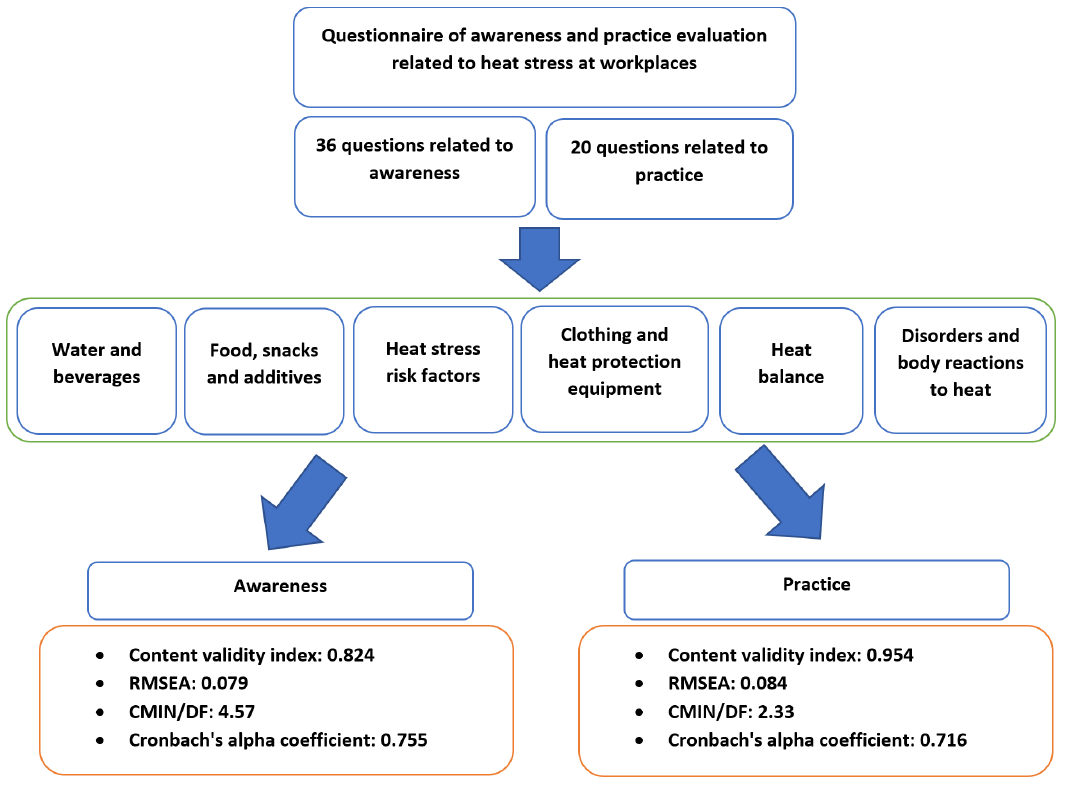Volume 12, Issue 1 (3-2022)
J Health Saf Work 2022, 12(1): 1-24 |
Back to browse issues page
Download citation:
BibTeX | RIS | EndNote | Medlars | ProCite | Reference Manager | RefWorks
Send citation to:



BibTeX | RIS | EndNote | Medlars | ProCite | Reference Manager | RefWorks
Send citation to:
Yazdanirad S, Golbabaei F, Khoshakhlagh A H, Sarsangi V, Yaseri M, Mousavi S M. Development and Validation of the Tools for Evaluating Awareness and Practice Related to Heat Stress among the Workers of Warm Workplaces. J Health Saf Work 2022; 12 (1) :1-24
URL: http://jhsw.tums.ac.ir/article-1-6630-en.html
URL: http://jhsw.tums.ac.ir/article-1-6630-en.html
Saeid Yazdanirad1 
 , Farideh Golbabaei *
, Farideh Golbabaei * 
 2, Amir Hossein Khoshakhlagh3
2, Amir Hossein Khoshakhlagh3 
 , Vali Sarsangi4
, Vali Sarsangi4 
 , Mehdi Yaseri5
, Mehdi Yaseri5 
 , Seyed Mahdi Mousavi4
, Seyed Mahdi Mousavi4 


 , Farideh Golbabaei *
, Farideh Golbabaei * 
 2, Amir Hossein Khoshakhlagh3
2, Amir Hossein Khoshakhlagh3 
 , Vali Sarsangi4
, Vali Sarsangi4 
 , Mehdi Yaseri5
, Mehdi Yaseri5 
 , Seyed Mahdi Mousavi4
, Seyed Mahdi Mousavi4 

1- School of Health, Shahrekord University of Medical Sciences, Shahrekord, Iran
2- Department of Occupational Health Engineering, School of Public Health, Tehran University of Medical Sciences, Tehran, Iran ,fgolbabaei@tums.ac.ir
3- Department of Occupational Health Engineering, Faculty of Health, Kashan University of Medical Sciences, Kashan, Iran
4- Department of Occupational Health Engineering, School of Public Health, Tehran University of Medical Sciences, Tehran, Iran
5- Department of Epidemiology and Biostatistics, School of Public Health, Tehran University of Medical Sciences, Tehran, Iran
2- Department of Occupational Health Engineering, School of Public Health, Tehran University of Medical Sciences, Tehran, Iran ,
3- Department of Occupational Health Engineering, Faculty of Health, Kashan University of Medical Sciences, Kashan, Iran
4- Department of Occupational Health Engineering, School of Public Health, Tehran University of Medical Sciences, Tehran, Iran
5- Department of Epidemiology and Biostatistics, School of Public Health, Tehran University of Medical Sciences, Tehran, Iran
Abstract: (2715 Views)
Introduction: Prevention of heat-related diseases requires the participation of the workers. For this reason, the aim of this study was the development and validation of the tools for evaluating awareness and practice related to heat stress among the workers of warm workplaces.
Material and Methods: The various items and factors related to the awareness and practice of the workers were identified by the literature review. Then, several questions for evaluating these items were designed. In the next step, the reliability and validity of the questionnaires were appraised using calculating the content validity ratio (CVR) and content validity index (CVI), and Cronbach’s alpha coefficient, respectively. After that, these questionnaires were completed by 2338 employees of six industries in various regions of Iran. Finally, collected data were analyzed using SPSS software.
Results: In total, 77 questions, including 53 questions on awareness and 24 questions on practice in six groups of water and beverages, food, snacks and additives, heat exchange, thermal strain risk factors, clothing and heat protection equipment, and heat-related disorders and body reactions, were designed. The values of content validity index (CVI) of remained questions in the questionnaires of awareness and practice were equal to 0.954 and 0.824, respectively. The values of Cronbach’s alpha coefficients of these questionnaires were calculated by 0.755 and 0.716, respectively. The values of the chi-square divided by degrees of freedom (CMIN/DF) and root mean square error of approximation (RMSEA) in the construction of the awareness questionnaire were computed as 4.58 and 0.079, respectively. These values in the construction of the practice questionnaire were calculated by 2.33 and 0.084, respectively.
Conclusion: The results showed that the designed questionnaires had appropriate reliability and validity and could be used to evaluate the awareness and practice in warm workplaces.
Material and Methods: The various items and factors related to the awareness and practice of the workers were identified by the literature review. Then, several questions for evaluating these items were designed. In the next step, the reliability and validity of the questionnaires were appraised using calculating the content validity ratio (CVR) and content validity index (CVI), and Cronbach’s alpha coefficient, respectively. After that, these questionnaires were completed by 2338 employees of six industries in various regions of Iran. Finally, collected data were analyzed using SPSS software.
Results: In total, 77 questions, including 53 questions on awareness and 24 questions on practice in six groups of water and beverages, food, snacks and additives, heat exchange, thermal strain risk factors, clothing and heat protection equipment, and heat-related disorders and body reactions, were designed. The values of content validity index (CVI) of remained questions in the questionnaires of awareness and practice were equal to 0.954 and 0.824, respectively. The values of Cronbach’s alpha coefficients of these questionnaires were calculated by 0.755 and 0.716, respectively. The values of the chi-square divided by degrees of freedom (CMIN/DF) and root mean square error of approximation (RMSEA) in the construction of the awareness questionnaire were computed as 4.58 and 0.079, respectively. These values in the construction of the practice questionnaire were calculated by 2.33 and 0.084, respectively.
Conclusion: The results showed that the designed questionnaires had appropriate reliability and validity and could be used to evaluate the awareness and practice in warm workplaces.
Type of Study: Research |
Received: 2022/03/6 | Accepted: 2022/03/30 | Published: 2022/03/30
Received: 2022/03/6 | Accepted: 2022/03/30 | Published: 2022/03/30
Send email to the article author
| Rights and permissions | |
 |
This work is licensed under a Creative Commons Attribution-NonCommercial 4.0 International License. |





